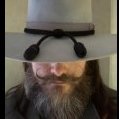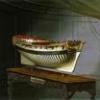Supplies of the Ship Modeler's Handbook are running out. Get your copy NOW before they are gone! Click on photo to order.
×
-
Posts
3,374 -
Joined
-
Last visited
Reputation Activity
-
 Cathead got a reaction from Elijah in USS Kearsarge by rtibbs2018 - BlueJacket Shipcrafters - Scale 1:96 - First ship build
Cathead got a reaction from Elijah in USS Kearsarge by rtibbs2018 - BlueJacket Shipcrafters - Scale 1:96 - First ship build
If this is your first ship build, what have you been doing with that fine workshop up until now? Whatever it was, I hope you enjoy this fun hobby.
-
 Cathead got a reaction from paulsutcliffe in 18th Century Long Boat by roach101761 - Model Shipways
Cathead got a reaction from paulsutcliffe in 18th Century Long Boat by roach101761 - Model Shipways
The fact that you felt the transom did not have problematic movement during fairing while braced that way supports the view that a few top braces are all that is required for the rest of the hull. Glad it worked fine for you.
-
 Cathead got a reaction from popeye the sailor in Arabia 1856 by Cathead - FINISHED - Scale 1:64 - sidewheel riverboat from the Missouri River, USA
Cathead got a reaction from popeye the sailor in Arabia 1856 by Cathead - FINISHED - Scale 1:64 - sidewheel riverboat from the Missouri River, USA
A quick update as planking progresses:
I've developed a steady and efficient approach to this tedious task. Every so often I pre-paint a bunch of planking strips so they're available in bulk, doing this lightly enough so the paint doesn't soak through to the bottom where it would look wrong on the underside of the guards. I've been working from the inside out, one side at a time. In a given work session, I do the following:
Measure and cut a full hull's length of individual planks along one side. Dip these in my dissolved steel wool & vinegar solution, wipe excess liquid free to avoid spotting, then set aside to dry. This darkens the paint and stains the underside a weathered brown. Take the strips I previously cut & soaked for the other side (in the last session), sand smooth any rough spots on edges or ends, rub on varying amounts of dark pastel (sometimes none) to vary the coloration and texture, then glue in place. This makes for a consistent rhythm and a manageable set of tasks whenever I can sit down at the desk. For example, in the photo above, the top (port) planking line has just been laid in place, while off-screen the pre-cut planking for the bottom (starboard) line is drying after the vinegar soak. It'll start going a bit faster once I each the guards, as half of the hull's length is already done from then on.
Progress will slow down for a few weeks as I'll be out of town visiting family in western NY, and may even get to attend part of this neat event hosted by the Model Shipwright Guild of Western NY.
-
 Cathead got a reaction from mtaylor in 18th Century Long Boat by roach101761 - Model Shipways
Cathead got a reaction from mtaylor in 18th Century Long Boat by roach101761 - Model Shipways
The fact that you felt the transom did not have problematic movement during fairing while braced that way supports the view that a few top braces are all that is required for the rest of the hull. Glad it worked fine for you.
-
 Cathead got a reaction from CaptainSteve in 18th Century Long Boat by roach101761 - Model Shipways
Cathead got a reaction from CaptainSteve in 18th Century Long Boat by roach101761 - Model Shipways
Phil,
I think there's a basic different in perspective operating here. I think you're focusing on what's "best" for the model, i.e. what produces the most perfect results regardless of effort or fuss. To me, and possibly Chuck (though I don't want to speak for him), what's more important in a beginner's build is what's "best" for the modeler even if it means a slight lowering of the model's standards. Most beginners aren't going to care about a very slight flex in the bulkheads as they fair and won't notice any difference in the finished model if it's not museum-quality straight. They are more likely to care about how easy and enjoyable the process is while they're deciding whether or not they like this hobby; if they do, they'll have plenty of time to learn to make things fussily perfect. Thus, a few minutes gluing strips along the top gets the beginner 95% of the way there with far less fuss and is good enough for 95% of beginners.
With all respect, I think you're trying to make a perfect model here when that's not really the priority of most beginners, and that may be why you're getting some dissent/feedback on some of the more intricate or fussy methodological choices. I don't think you'd be getting any pushback from commenters if this was simply your own build and you were doing your darndest to make it perfect. But in this case, I wonder whether sometimes the perfect is the enemy of the inspiring.
-
 Cathead got a reaction from Jack12477 in 18th Century Long Boat by roach101761 - Model Shipways
Cathead got a reaction from Jack12477 in 18th Century Long Boat by roach101761 - Model Shipways
The fact that you felt the transom did not have problematic movement during fairing while braced that way supports the view that a few top braces are all that is required for the rest of the hull. Glad it worked fine for you.
-
 Cathead got a reaction from CaptainSteve in Arabia 1856 by Cathead - FINISHED - Scale 1:64 - sidewheel riverboat from the Missouri River, USA
Cathead got a reaction from CaptainSteve in Arabia 1856 by Cathead - FINISHED - Scale 1:64 - sidewheel riverboat from the Missouri River, USA
A quick update as planking progresses:
I've developed a steady and efficient approach to this tedious task. Every so often I pre-paint a bunch of planking strips so they're available in bulk, doing this lightly enough so the paint doesn't soak through to the bottom where it would look wrong on the underside of the guards. I've been working from the inside out, one side at a time. In a given work session, I do the following:
Measure and cut a full hull's length of individual planks along one side. Dip these in my dissolved steel wool & vinegar solution, wipe excess liquid free to avoid spotting, then set aside to dry. This darkens the paint and stains the underside a weathered brown. Take the strips I previously cut & soaked for the other side (in the last session), sand smooth any rough spots on edges or ends, rub on varying amounts of dark pastel (sometimes none) to vary the coloration and texture, then glue in place. This makes for a consistent rhythm and a manageable set of tasks whenever I can sit down at the desk. For example, in the photo above, the top (port) planking line has just been laid in place, while off-screen the pre-cut planking for the bottom (starboard) line is drying after the vinegar soak. It'll start going a bit faster once I each the guards, as half of the hull's length is already done from then on.
Progress will slow down for a few weeks as I'll be out of town visiting family in western NY, and may even get to attend part of this neat event hosted by the Model Shipwright Guild of Western NY.
-
 Cathead got a reaction from popeye the sailor in USS Kearsarge by rtibbs2018 - BlueJacket Shipcrafters - Scale 1:96 - First ship build
Cathead got a reaction from popeye the sailor in USS Kearsarge by rtibbs2018 - BlueJacket Shipcrafters - Scale 1:96 - First ship build
If this is your first ship build, what have you been doing with that fine workshop up until now? Whatever it was, I hope you enjoy this fun hobby.
-
 Cathead got a reaction from toms10 in How Realistic Can One Make Sails?
Cathead got a reaction from toms10 in How Realistic Can One Make Sails?
Bob, your points are well taken, but it does really come down to modeler's preference. The vast majority of us aren't building for museums and public display. I'm not sure what you mean by a "serious" modeler, but plenty of folks willing to devote years to a detailed and reasonably accurate model still aren't doing so for the museum curator crowd, but for family/friend home display. To non-sailors or non-enthusiasts, a ship with sails often looks far more interesting and recognizable, as the web of rigging goes right over their head anyway but the sails are more easily comprehended. Speaking personally as a moderately skilled amateur, I'm happy to learn about what's considered "perfect", but may still not choose to apply that standard to even a "serious" model if my goal is to please a less picky audience and work to a standard that makes me happy rather than drives me crazy.
-
 Cathead got a reaction from mtaylor in USS Kearsarge by rtibbs2018 - BlueJacket Shipcrafters - Scale 1:96 - First ship build
Cathead got a reaction from mtaylor in USS Kearsarge by rtibbs2018 - BlueJacket Shipcrafters - Scale 1:96 - First ship build
If this is your first ship build, what have you been doing with that fine workshop up until now? Whatever it was, I hope you enjoy this fun hobby.
-
 Cathead got a reaction from hexnut in Arabia 1856 by Cathead - FINISHED - Scale 1:64 - sidewheel riverboat from the Missouri River, USA
Cathead got a reaction from hexnut in Arabia 1856 by Cathead - FINISHED - Scale 1:64 - sidewheel riverboat from the Missouri River, USA
A quick update as planking progresses:
I've developed a steady and efficient approach to this tedious task. Every so often I pre-paint a bunch of planking strips so they're available in bulk, doing this lightly enough so the paint doesn't soak through to the bottom where it would look wrong on the underside of the guards. I've been working from the inside out, one side at a time. In a given work session, I do the following:
Measure and cut a full hull's length of individual planks along one side. Dip these in my dissolved steel wool & vinegar solution, wipe excess liquid free to avoid spotting, then set aside to dry. This darkens the paint and stains the underside a weathered brown. Take the strips I previously cut & soaked for the other side (in the last session), sand smooth any rough spots on edges or ends, rub on varying amounts of dark pastel (sometimes none) to vary the coloration and texture, then glue in place. This makes for a consistent rhythm and a manageable set of tasks whenever I can sit down at the desk. For example, in the photo above, the top (port) planking line has just been laid in place, while off-screen the pre-cut planking for the bottom (starboard) line is drying after the vinegar soak. It'll start going a bit faster once I each the guards, as half of the hull's length is already done from then on.
Progress will slow down for a few weeks as I'll be out of town visiting family in western NY, and may even get to attend part of this neat event hosted by the Model Shipwright Guild of Western NY.
-
 Cathead got a reaction from Canute in USS Kearsarge by rtibbs2018 - BlueJacket Shipcrafters - Scale 1:96 - First ship build
Cathead got a reaction from Canute in USS Kearsarge by rtibbs2018 - BlueJacket Shipcrafters - Scale 1:96 - First ship build
If this is your first ship build, what have you been doing with that fine workshop up until now? Whatever it was, I hope you enjoy this fun hobby.
-
 Cathead got a reaction from G.L. in Arabia 1856 by Cathead - FINISHED - Scale 1:64 - sidewheel riverboat from the Missouri River, USA
Cathead got a reaction from G.L. in Arabia 1856 by Cathead - FINISHED - Scale 1:64 - sidewheel riverboat from the Missouri River, USA
A quick update as planking progresses:
I've developed a steady and efficient approach to this tedious task. Every so often I pre-paint a bunch of planking strips so they're available in bulk, doing this lightly enough so the paint doesn't soak through to the bottom where it would look wrong on the underside of the guards. I've been working from the inside out, one side at a time. In a given work session, I do the following:
Measure and cut a full hull's length of individual planks along one side. Dip these in my dissolved steel wool & vinegar solution, wipe excess liquid free to avoid spotting, then set aside to dry. This darkens the paint and stains the underside a weathered brown. Take the strips I previously cut & soaked for the other side (in the last session), sand smooth any rough spots on edges or ends, rub on varying amounts of dark pastel (sometimes none) to vary the coloration and texture, then glue in place. This makes for a consistent rhythm and a manageable set of tasks whenever I can sit down at the desk. For example, in the photo above, the top (port) planking line has just been laid in place, while off-screen the pre-cut planking for the bottom (starboard) line is drying after the vinegar soak. It'll start going a bit faster once I each the guards, as half of the hull's length is already done from then on.
Progress will slow down for a few weeks as I'll be out of town visiting family in western NY, and may even get to attend part of this neat event hosted by the Model Shipwright Guild of Western NY.
-
 Cathead got a reaction from Bob Legge in Arabia 1856 by Cathead - FINISHED - Scale 1:64 - sidewheel riverboat from the Missouri River, USA
Cathead got a reaction from Bob Legge in Arabia 1856 by Cathead - FINISHED - Scale 1:64 - sidewheel riverboat from the Missouri River, USA
A quick update as planking progresses:
I've developed a steady and efficient approach to this tedious task. Every so often I pre-paint a bunch of planking strips so they're available in bulk, doing this lightly enough so the paint doesn't soak through to the bottom where it would look wrong on the underside of the guards. I've been working from the inside out, one side at a time. In a given work session, I do the following:
Measure and cut a full hull's length of individual planks along one side. Dip these in my dissolved steel wool & vinegar solution, wipe excess liquid free to avoid spotting, then set aside to dry. This darkens the paint and stains the underside a weathered brown. Take the strips I previously cut & soaked for the other side (in the last session), sand smooth any rough spots on edges or ends, rub on varying amounts of dark pastel (sometimes none) to vary the coloration and texture, then glue in place. This makes for a consistent rhythm and a manageable set of tasks whenever I can sit down at the desk. For example, in the photo above, the top (port) planking line has just been laid in place, while off-screen the pre-cut planking for the bottom (starboard) line is drying after the vinegar soak. It'll start going a bit faster once I each the guards, as half of the hull's length is already done from then on.
Progress will slow down for a few weeks as I'll be out of town visiting family in western NY, and may even get to attend part of this neat event hosted by the Model Shipwright Guild of Western NY.
-
 Cathead got a reaction from JesseLee in How Realistic Can One Make Sails?
Cathead got a reaction from JesseLee in How Realistic Can One Make Sails?
Bob, your points are well taken, but it does really come down to modeler's preference. The vast majority of us aren't building for museums and public display. I'm not sure what you mean by a "serious" modeler, but plenty of folks willing to devote years to a detailed and reasonably accurate model still aren't doing so for the museum curator crowd, but for family/friend home display. To non-sailors or non-enthusiasts, a ship with sails often looks far more interesting and recognizable, as the web of rigging goes right over their head anyway but the sails are more easily comprehended. Speaking personally as a moderately skilled amateur, I'm happy to learn about what's considered "perfect", but may still not choose to apply that standard to even a "serious" model if my goal is to please a less picky audience and work to a standard that makes me happy rather than drives me crazy.
-
 Cathead reacted to Jim Lad in Arabia 1856 by Cathead - FINISHED - Scale 1:64 - sidewheel riverboat from the Missouri River, USA
Cathead reacted to Jim Lad in Arabia 1856 by Cathead - FINISHED - Scale 1:64 - sidewheel riverboat from the Missouri River, USA
Coming along very nicely.
John
-
 Cathead reacted to rtibbs2018 in USS Kearsarge by rtibbs2018 - BlueJacket Shipcrafters - Scale 1:96 - First ship build
Cathead reacted to rtibbs2018 in USS Kearsarge by rtibbs2018 - BlueJacket Shipcrafters - Scale 1:96 - First ship build
Building kit and plans built RC model aircraft since the late 60's
-
 Cathead got a reaction from tlevine in Arabia 1856 by Cathead - FINISHED - Scale 1:64 - sidewheel riverboat from the Missouri River, USA
Cathead got a reaction from tlevine in Arabia 1856 by Cathead - FINISHED - Scale 1:64 - sidewheel riverboat from the Missouri River, USA
A quick update as planking progresses:
I've developed a steady and efficient approach to this tedious task. Every so often I pre-paint a bunch of planking strips so they're available in bulk, doing this lightly enough so the paint doesn't soak through to the bottom where it would look wrong on the underside of the guards. I've been working from the inside out, one side at a time. In a given work session, I do the following:
Measure and cut a full hull's length of individual planks along one side. Dip these in my dissolved steel wool & vinegar solution, wipe excess liquid free to avoid spotting, then set aside to dry. This darkens the paint and stains the underside a weathered brown. Take the strips I previously cut & soaked for the other side (in the last session), sand smooth any rough spots on edges or ends, rub on varying amounts of dark pastel (sometimes none) to vary the coloration and texture, then glue in place. This makes for a consistent rhythm and a manageable set of tasks whenever I can sit down at the desk. For example, in the photo above, the top (port) planking line has just been laid in place, while off-screen the pre-cut planking for the bottom (starboard) line is drying after the vinegar soak. It'll start going a bit faster once I each the guards, as half of the hull's length is already done from then on.
Progress will slow down for a few weeks as I'll be out of town visiting family in western NY, and may even get to attend part of this neat event hosted by the Model Shipwright Guild of Western NY.
-
 Cathead got a reaction from rtwpsom2 in USS Kearsarge by rtibbs2018 - BlueJacket Shipcrafters - Scale 1:96 - First ship build
Cathead got a reaction from rtwpsom2 in USS Kearsarge by rtibbs2018 - BlueJacket Shipcrafters - Scale 1:96 - First ship build
If this is your first ship build, what have you been doing with that fine workshop up until now? Whatever it was, I hope you enjoy this fun hobby.
-
 Cathead reacted to rtibbs2018 in USS Kearsarge by rtibbs2018 - BlueJacket Shipcrafters - Scale 1:96 - First ship build
Cathead reacted to rtibbs2018 in USS Kearsarge by rtibbs2018 - BlueJacket Shipcrafters - Scale 1:96 - First ship build
They give the option to construct the hull with a reveal which shows chain placed at strategic locations within the hull for additional protection from cannon shot. I elected to build it without the reveal. Something about seeing a hull with a hole in it's side didn't appeal to me.
I'm also including some balsa triangles to add additional support to the bulkheads in case "heavy hands" gets carried away in the fairing of the bulkheads.
Starboard bulkheads being glued in place.
Port side bulkheads
Support cradle to keep everything aligned
All bulkheads in place with balsa triangles in addition to the basswood pieces supplied with the kit
Ready for the false deck
Dry fitting
Deck gluing
Dry fitting of bow and stern jigs for planking
Now it's time to cut and fit bow and stern filler blocks.
Sure is good to get back to building. Almost forgot how nice it is to chew CA from ones fingers.
-
 Cathead got a reaction from yvesvidal in Arabia 1856 by Cathead - FINISHED - Scale 1:64 - sidewheel riverboat from the Missouri River, USA
Cathead got a reaction from yvesvidal in Arabia 1856 by Cathead - FINISHED - Scale 1:64 - sidewheel riverboat from the Missouri River, USA
A quick update as planking progresses:
I've developed a steady and efficient approach to this tedious task. Every so often I pre-paint a bunch of planking strips so they're available in bulk, doing this lightly enough so the paint doesn't soak through to the bottom where it would look wrong on the underside of the guards. I've been working from the inside out, one side at a time. In a given work session, I do the following:
Measure and cut a full hull's length of individual planks along one side. Dip these in my dissolved steel wool & vinegar solution, wipe excess liquid free to avoid spotting, then set aside to dry. This darkens the paint and stains the underside a weathered brown. Take the strips I previously cut & soaked for the other side (in the last session), sand smooth any rough spots on edges or ends, rub on varying amounts of dark pastel (sometimes none) to vary the coloration and texture, then glue in place. This makes for a consistent rhythm and a manageable set of tasks whenever I can sit down at the desk. For example, in the photo above, the top (port) planking line has just been laid in place, while off-screen the pre-cut planking for the bottom (starboard) line is drying after the vinegar soak. It'll start going a bit faster once I each the guards, as half of the hull's length is already done from then on.
Progress will slow down for a few weeks as I'll be out of town visiting family in western NY, and may even get to attend part of this neat event hosted by the Model Shipwright Guild of Western NY.
-
 Cathead got a reaction from RichardG in How Realistic Can One Make Sails?
Cathead got a reaction from RichardG in How Realistic Can One Make Sails?
Bob, your points are well taken, but it does really come down to modeler's preference. The vast majority of us aren't building for museums and public display. I'm not sure what you mean by a "serious" modeler, but plenty of folks willing to devote years to a detailed and reasonably accurate model still aren't doing so for the museum curator crowd, but for family/friend home display. To non-sailors or non-enthusiasts, a ship with sails often looks far more interesting and recognizable, as the web of rigging goes right over their head anyway but the sails are more easily comprehended. Speaking personally as a moderately skilled amateur, I'm happy to learn about what's considered "perfect", but may still not choose to apply that standard to even a "serious" model if my goal is to please a less picky audience and work to a standard that makes me happy rather than drives me crazy.
-
 Cathead got a reaction from oneslim in Arabia 1856 by Cathead - FINISHED - Scale 1:64 - sidewheel riverboat from the Missouri River, USA
Cathead got a reaction from oneslim in Arabia 1856 by Cathead - FINISHED - Scale 1:64 - sidewheel riverboat from the Missouri River, USA
A quick update as planking progresses:
I've developed a steady and efficient approach to this tedious task. Every so often I pre-paint a bunch of planking strips so they're available in bulk, doing this lightly enough so the paint doesn't soak through to the bottom where it would look wrong on the underside of the guards. I've been working from the inside out, one side at a time. In a given work session, I do the following:
Measure and cut a full hull's length of individual planks along one side. Dip these in my dissolved steel wool & vinegar solution, wipe excess liquid free to avoid spotting, then set aside to dry. This darkens the paint and stains the underside a weathered brown. Take the strips I previously cut & soaked for the other side (in the last session), sand smooth any rough spots on edges or ends, rub on varying amounts of dark pastel (sometimes none) to vary the coloration and texture, then glue in place. This makes for a consistent rhythm and a manageable set of tasks whenever I can sit down at the desk. For example, in the photo above, the top (port) planking line has just been laid in place, while off-screen the pre-cut planking for the bottom (starboard) line is drying after the vinegar soak. It'll start going a bit faster once I each the guards, as half of the hull's length is already done from then on.
Progress will slow down for a few weeks as I'll be out of town visiting family in western NY, and may even get to attend part of this neat event hosted by the Model Shipwright Guild of Western NY.
-
 Cathead got a reaction from druxey in Arabia 1856 by Cathead - FINISHED - Scale 1:64 - sidewheel riverboat from the Missouri River, USA
Cathead got a reaction from druxey in Arabia 1856 by Cathead - FINISHED - Scale 1:64 - sidewheel riverboat from the Missouri River, USA
A quick update as planking progresses:
I've developed a steady and efficient approach to this tedious task. Every so often I pre-paint a bunch of planking strips so they're available in bulk, doing this lightly enough so the paint doesn't soak through to the bottom where it would look wrong on the underside of the guards. I've been working from the inside out, one side at a time. In a given work session, I do the following:
Measure and cut a full hull's length of individual planks along one side. Dip these in my dissolved steel wool & vinegar solution, wipe excess liquid free to avoid spotting, then set aside to dry. This darkens the paint and stains the underside a weathered brown. Take the strips I previously cut & soaked for the other side (in the last session), sand smooth any rough spots on edges or ends, rub on varying amounts of dark pastel (sometimes none) to vary the coloration and texture, then glue in place. This makes for a consistent rhythm and a manageable set of tasks whenever I can sit down at the desk. For example, in the photo above, the top (port) planking line has just been laid in place, while off-screen the pre-cut planking for the bottom (starboard) line is drying after the vinegar soak. It'll start going a bit faster once I each the guards, as half of the hull's length is already done from then on.
Progress will slow down for a few weeks as I'll be out of town visiting family in western NY, and may even get to attend part of this neat event hosted by the Model Shipwright Guild of Western NY.
-
 Cathead got a reaction from Jack12477 in Arabia 1856 by Cathead - FINISHED - Scale 1:64 - sidewheel riverboat from the Missouri River, USA
Cathead got a reaction from Jack12477 in Arabia 1856 by Cathead - FINISHED - Scale 1:64 - sidewheel riverboat from the Missouri River, USA
A quick update as planking progresses:
I've developed a steady and efficient approach to this tedious task. Every so often I pre-paint a bunch of planking strips so they're available in bulk, doing this lightly enough so the paint doesn't soak through to the bottom where it would look wrong on the underside of the guards. I've been working from the inside out, one side at a time. In a given work session, I do the following:
Measure and cut a full hull's length of individual planks along one side. Dip these in my dissolved steel wool & vinegar solution, wipe excess liquid free to avoid spotting, then set aside to dry. This darkens the paint and stains the underside a weathered brown. Take the strips I previously cut & soaked for the other side (in the last session), sand smooth any rough spots on edges or ends, rub on varying amounts of dark pastel (sometimes none) to vary the coloration and texture, then glue in place. This makes for a consistent rhythm and a manageable set of tasks whenever I can sit down at the desk. For example, in the photo above, the top (port) planking line has just been laid in place, while off-screen the pre-cut planking for the bottom (starboard) line is drying after the vinegar soak. It'll start going a bit faster once I each the guards, as half of the hull's length is already done from then on.
Progress will slow down for a few weeks as I'll be out of town visiting family in western NY, and may even get to attend part of this neat event hosted by the Model Shipwright Guild of Western NY.
















